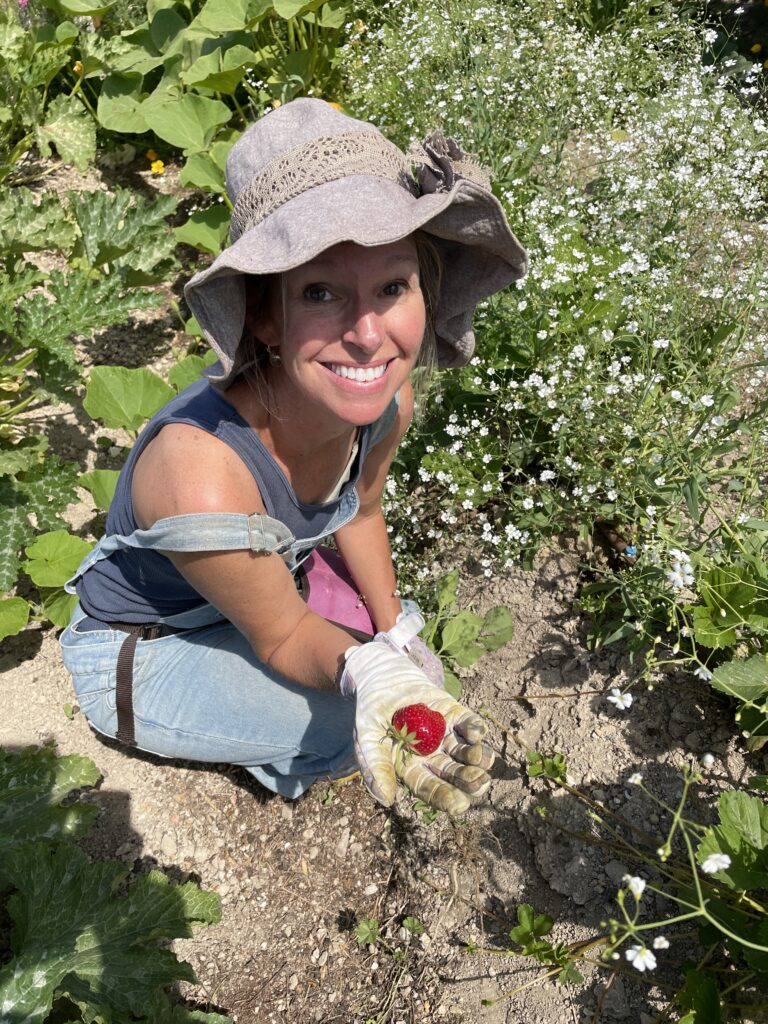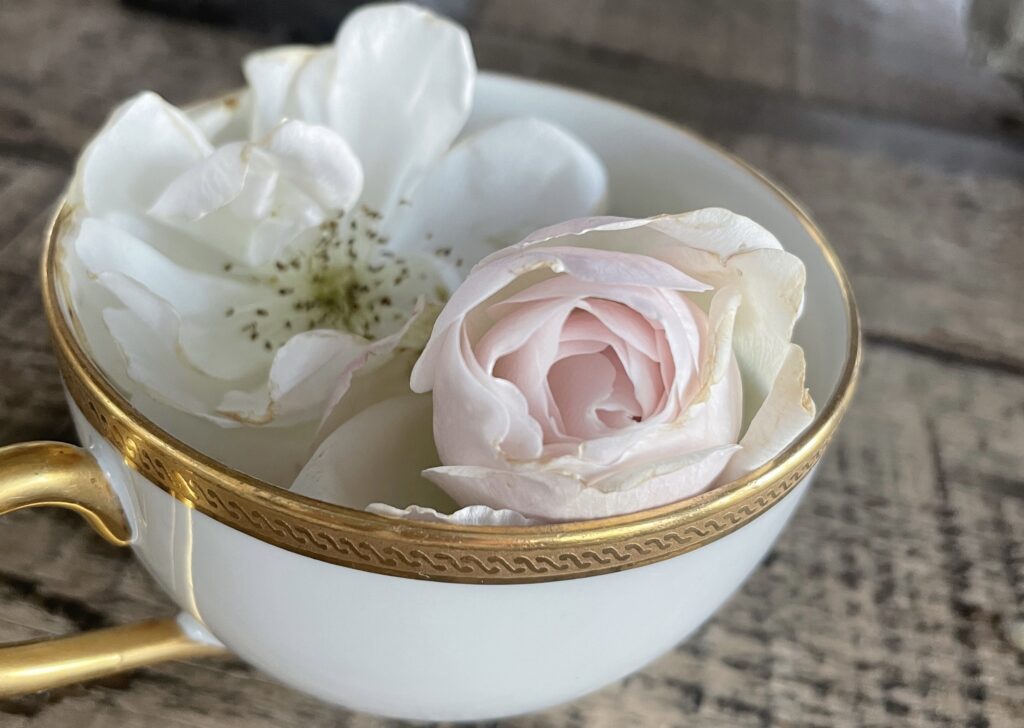
I have a story to tell, but you’ll need to bare with me as it takes some twists and turns. Somewhere in the path of these seemingly unrelated events, is one singular example of life’s perfect symmetry. Having experienced this, it makes me wonder about the thousands of other synchronicities that float by us, unnoticed.
It starts with one of my dear friends Adrienne making a simple, matter of fact comment.
“Lyd- have you ever noticed you use the word little really often— little this, little that. You say it a lot! “ she blurted emphatically.
In that moment, these words felt like a critique, and I could slowly sense an internal wall of defense rising within me. Yes, of course, I had noticed my use of the word. It has played—and continues to play—a role in my life, from small, everyday ways to more overarching, shall we say, karmic ones.
I like small things, fragile things—bits of this and that. Little fluffy feathers and small dogs. In the morning I like a little corner of a piece of chocolate, maybe two, with my coffee, or a bit of a biscuit, but only the broken edge. We have a big king-sized bed, yet I find myself slipping down to the floor in the middle of the night where there is a little nook in between the mattress and the tall wall. I have made myself a nest down there. It feels warm and safe. When the window is open, I have the most perfect, unobstructed view of the stars and the moon. It’s not just about the small and cozy space, but the amazing expanse that you can see from it. Who would have known that the best view of the starry night could be found from a small slice of space on the floor in my bedroom.
My husband and I have had many a battle over the years where big versus small seemed to be at the source of the debate. Houses, cars, the size of the package of toilet paper rolls to buy at the grocery store. He loads up the biggest one in the cart while I grab the small one that can fit in a little hand.
It’s not a right or wrong thing— it just is.
And by the way, I have decided that as I write this story, I won’t hold back my natural use of our little word. I am going to let her pop in as she sees fit, wherever she wants. Let’s let her play like a sprite in a enchanted forest.
Yes, this little conversation has always been present for me.
As a child I felt small. Like a bird. It wasn’t about being particularly small, I just felt little. Some days this had its advantages. I could observe quietly, invisibly, from a different vantage point. Stuff was going on out there and I could see and feel it, without being noticed. At other times a sense of deep fragility came with it, like a weakness of sorts. It made me wonder whether when we all lined up to enter the universe, I was skipped over and sent down to the earth, unprepared, without layers of protection the rest had been equipped with–like thicker skin.
Later in life I could quickly identify others who were from the same little tribe. I was able to feel them from a mile away, pick up on their unique brand of sensitivity. But I could also see what sat behind this facade, where there seemed to be a vast field with a wellspring of something unexpected, something beautiful and curiously strong. It’s been my little secret since.
I’ve always felt that little things reveal their power most in small acts of kindness. For years, I was part of building a foundation where every act, effort, and contribution made a difference in the lives of many. We helped people in faraway places who had fewer of life’s big things.
I felt people were drawn to our work not by flashy fundraising galas ( we had simple ones) or flyers in the mailbox (we preferred word of mouth), but through the little thoughts —the ones that float through our minds and nest in our hearts. The ones that come from some other place, a good one–that pure place that can feel very far away. These thoughts have us caring, feeling– loving, even when thousands of miles divide us. They can be so incredibly brief and subtle, these little thoughts, coming and going quickly like small winged bugs with paper thin wings. You might barely notice them, yet the weird thing is that there is this tremendous force behind them. And when they are released into the world, well…that’s when things get interesting.
But, somewhere along my life line, I reached a point where the big world felt too much to manage. The harsh and mean and painful were magnified to a point where it felt like everyone had oversized boots and they stomped around to get things done. I tried those boots on myself thinking it would help, but it all just felt wrong and ugly. Maybe I’m just not meant for this big place, I wondered. So I retreated, taking solace in the gentle wind, caring for small fragile things with my hands. I turned my attention to sowing patches of flowers and herbs, and tending to rows of perfectly sweet strawberries in my garden.
Yes, I could go on and on about about little things.
So when Adrienne made that comment, I thought long and hard about it. It was clear it had unsettled me—not because it was out of line or hurtful, but because she was right.
Then, weeks later, it hit me: my creative exercise would be to write about it. I wanted to share, to voice, and yes, maybe even defend the beauty in these small things. I felt there was something meaningful in them—something strong, important, and essential to this big life experience. Maybe, in doing so, I could finally convince myself that my quiet longing to exist in the space of little things was justified. The world around me certainly wasn’t going to do that. It seemed to have a different agenda.
So I made a note that week in my diary, a commitment to myself, to write about it. I scratched the words next to two other events that I wanted to make happen in the days that followed. At the time, all three of these to-do’s felt entirely unrelated.
Cold water plunge with Ellie
Tea with the neighbors
“Little Things” writing
But the week got away from me —gobbled up by other big projects and I didn’t follow through on my writing commitment. I was disappointed in myself. Just one more example of how these things went–the little things don’t get the limelight they deserve. Who would have known though, that the other two seemingly separate items that I had noted in my diary, would be essential in what unfolded.
Ellie was a friend who was going through a difficult time–there was a heaviness to her. I could think of only one thing.
“You need a cold plunge in the pool to cleanse some of the fear. It will do you good.” I said.
She thought my practice of cold plunges was crazy, but it had been a transformative, both physically and psychologically for me that year. There was something empowering about overcoming extreme discomfort, facing full on a fear of something so fundamental- the cold. Ellie was always wrapped up and protected , bundled in sweaters, coats and scarves. The thought of immersing herself in freezing water made her want to run for the hills, in a snow suit.
“It’s time,” I told her. We set a date for the 14th of February, Valentine’s Day. “It only takes a few small minutes,” I explained.
She walked into the house on that day, brave and ready, with the sweetest little smile on her face. She handed me the loveliest bouquet of flowers, with three plump white roses at the center. What an unexpected and thoughtful gift, I thought as I placed them in the center of the table.
We started by doing some breathing exercises. I lit some incense as I do as a ritual, and we entered the pool, holding hands. It was a beautiful day and the Provencal sun warmed our faces as our insides braced the frigid, uncomfortable water. It was a special moment together, with few words spoken as we asked our bodies to search for, and discover, a strength it had forgotten it had. She was radiant as she climbed out.
Every time I looked at the roses that week, I thought of our beautiful moment together.
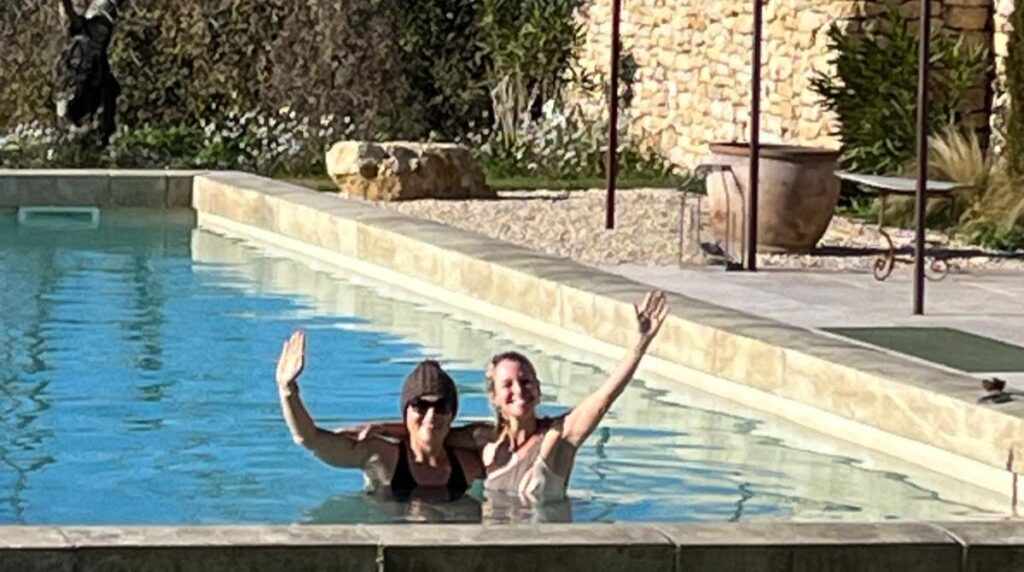
Remember that I warned you that there would be some twists and turns in this story. Well beware, we are heading for a corner in the road. A few days later I progressed down the list I had made in my journal. My three neighbors Marie-Jeanne, Bernadette and Monique were due to come over for tea. It was Friday and I had decided the work week would end early that morning. I was thrilled I get out my china cups with painted flowers. I placed some cookies on a plate. The sun was shining brightly on the wooden table and I felt giddy, like a little girl having a tea party.
It has been nearly six years since we bought our pile of ancient stones on this property and began our own journey here. These three strong, caring women—and their husbands—embody a wisdom and dignity that are difficult to put into words. From the moment we arrived, they have shown us kindness in more ways than I can count.
We sat together for over two hours, discussing an idea that had surfaced, somewhat collectively, the previous summer—the possibility of writing a book about what makes Les Agnels so special. Our hamlet is not unlike hundreds of others in the region, all with histories deeply rooted in the rhythms of agricultural life. Yet, there is something undeniably unique about it, and we all feel it.
It’s as if the air itself is charged—alive with something unseen yet unmistakable. Maybe it has to do with its long history of lavender distillation, the flower known for its purifying and healing properties. Tourists come from far and wide to experience the essence of this delicate bloom, which has been at the heart of life here for so long.
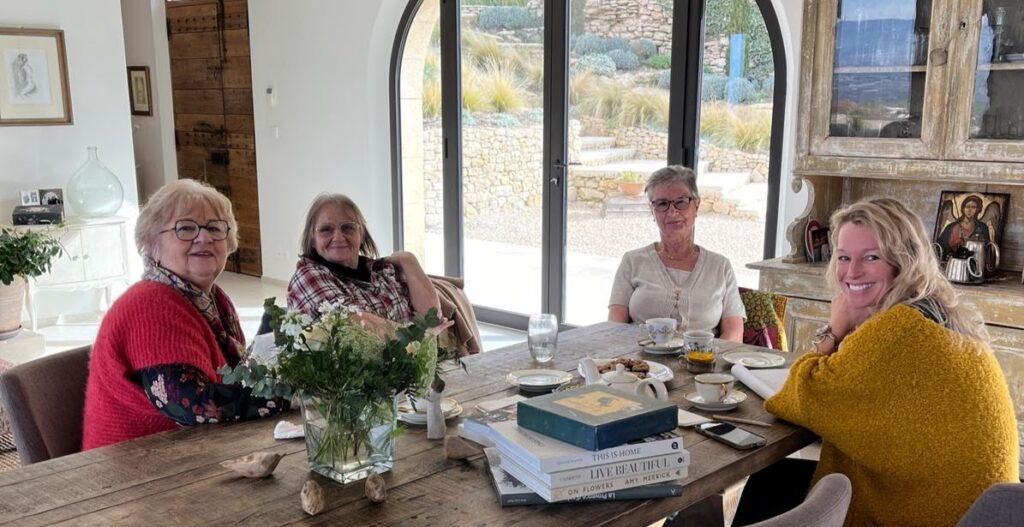
In the middle of the table between the us sat the vase with Ellie’s bouquet. At one point I saw Bernadette’s attention turn to it. Glancing up at me, she asked about the flowers. So I told the ladies about Ellie and the water. Without saying too much, I shared the beauty in our little moment in the pool. At some point the table went quiet and it was clear it was time for them to go home and make lunch for their husbands. Our sweet moment together was over.
On the way out, Bernadette asked to take a tour of the courtyard where we have been restoring a small stone cave that we affectionately call our chapel. I led her by the elbow, steadying her slightly unstable gait, across the gravel path, towards the arched entryway. She took slow steps, breathing in the air, admiring the changes we had made to what had been an abandoned collection of tumbling walls for over a hundred years.
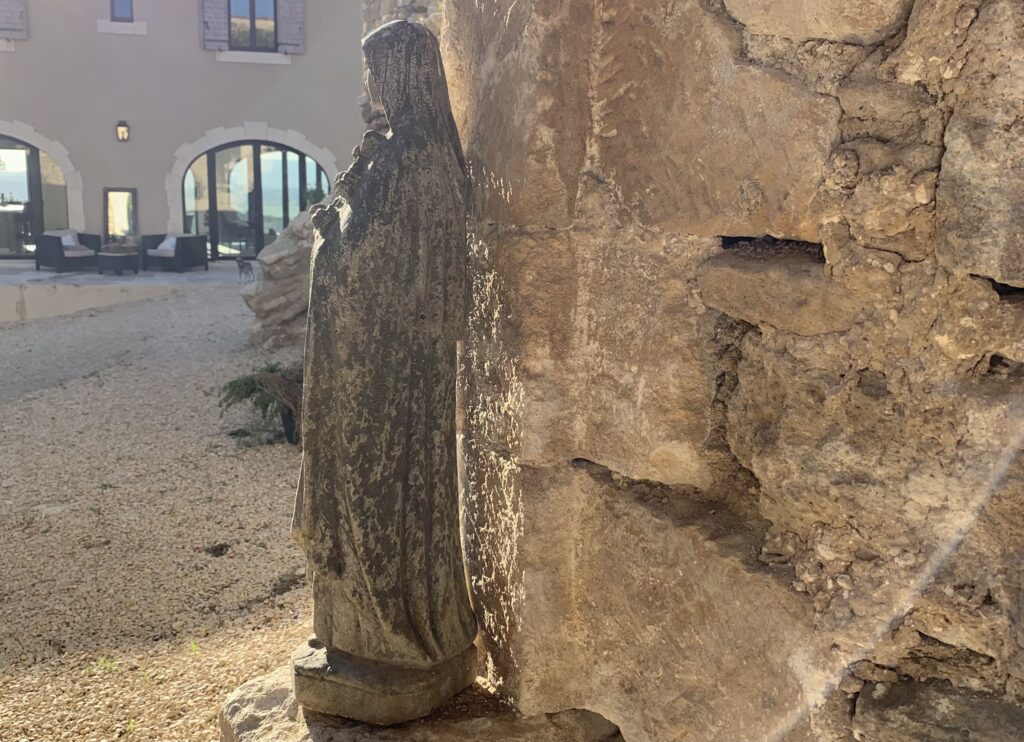 We stopped at the entrance of the chapel where a statue of the Virgin Mary sits perched on a stone. My relationship with Mary had begun years prior, not out of any religious affiliation, but simply from a deep connection and respect for what her figure seemed to communicate every time I set eyes on her.
We stopped at the entrance of the chapel where a statue of the Virgin Mary sits perched on a stone. My relationship with Mary had begun years prior, not out of any religious affiliation, but simply from a deep connection and respect for what her figure seemed to communicate every time I set eyes on her.
Years prior, during a tender and difficult moment in my life, I had traveled to Calcutta to spend some time working in Mother Teresa’s home for the sick and dying. She had been my mentor since I was a child and I felt a need to thank her for inspiring me in the building of our foundation. When I arrived, each volunteer was given a small plastic medallion of Mother Mary. I would later find that the residents of the home also wore these medallions around their necks. These little plastic charms had a powerful way of uniting us, dissolving any sense of who was giving and who was receiving.
 It was during this time that I began to pay more closer attention to the look on Mary’s face. Her features were soft, yet resilient, emitting a combination of strength, compassion, and patience. It was as if she could sit quietly, holding a safe and loving space for each one of us, for eternity. Overtime I learned that if I opened my heart to her, I could draw from her essence. I was amazed at how accessible this was, how abundant her gifts were. Later on that journey in India I was given a real silver medallion by a dear friend who had worn it throughout her life, on the good days and the bad ones. To this day I treasure this gift, wearing it when I think both courage and compassion might be needed.
It was during this time that I began to pay more closer attention to the look on Mary’s face. Her features were soft, yet resilient, emitting a combination of strength, compassion, and patience. It was as if she could sit quietly, holding a safe and loving space for each one of us, for eternity. Overtime I learned that if I opened my heart to her, I could draw from her essence. I was amazed at how accessible this was, how abundant her gifts were. Later on that journey in India I was given a real silver medallion by a dear friend who had worn it throughout her life, on the good days and the bad ones. To this day I treasure this gift, wearing it when I think both courage and compassion might be needed.
When I returned from my time in Calcutta I found a stone statue of what I thought to be the Virgin Mary. When we were renovating our courtyard in Les Agnels, it felt natural that she be placed in front of the chapel. She can watch over the space as it transforms, I thought, where the birds fly here and there, nesting in the stones.

“Who is this statue?” asked Bernadette. I was a little taken aback because it seemed so obvious. “It’s the Virgin Mary,” I responded.
“Non – je crois pas. I don’t think so. It looks like Saint Thérèse de Lisieux,” she said confidently.
“The white roses on your table from your friend made me think of this,” she added.
“Look at the roses she holds next to her heart. You will always know its her when you see the roses.”
I stood there for a second, in a bit of shock. I was very sad that the statue wasn’t of Mary. I felt dumb actually, maybe even a little annoyed. While Saint Thérèse must have done something very good and important to have become a saint, let’s face it—she’s an entirely different woman.
Bernadette gave me kisses on my cheeks and bid me farewell, returning home down the ancient cobblestone path, past the fig tree, cherry groves and her chicken coop. I quietly wandered back to the house to tidy up the tea party. Still a bit doubtful, I made a note to read about this Saint Thérèse . I’ll get to the bottom of this, I thought.
The following morning I got up. Sipping my coffee I picked up the book I had been reading for two years —Thomas Merton’s The Seven Story Mountain. It had been taking me a long time to read as I was savoring the chapters, loving how the stepping stones of his life had flowed through so many similar locations to mine—England, Update NY, then Apt and Gordes, now close to my home here in Provence. I tucked into one of the last chapters and lo and behold, who does he refer to but Thérèse of Lisieux. Wow, I thought to myself. What are the odds of that coincidence? Just yesterday I had never heard of her.
Ok, it was time to learn more. I put down the book and looked for my computer. Googling her I was immediately surprised at what I found and how it related both to my life and to the timing of my assignment on little things.
Saint Thérèse of Lisieux is also called the Little Flower. She is most known for her “Little Way.” She spoke not of doing great things, but of small things with great love. Therese acknowledged her littleness and believed this showed more clearly greatness that could be in actions. She once said, “If all the lowly flowers wished to be roses, nature would lose its springtime beauty.” It is not the greatness of what we do that matters, but the love with which we do them.
She lived in France as a nun, and died at 24 from tuberculosis. Saint Thérèse is the patroness of florists. She loved flowers and mentioned them often. “When I die, I will send forth a shower of roses from the heavens.”

Amazed, I continued to learn how Mother Mary played an important role in her life. Thérèse had had a vision of her early in life, after the painful death of her mother when she had only been a young girl. The vision of this graceful Mary figure had given her the strength to pursue her life’s mission of devotion, to small acts of kindness.
I suddenly realized an interesting thing. She had the same name as Mother Teresa. Was this by coincidence? Reading on, I learned that Mother Teresa had been especially drawn to the power of the “little ways.” After settling in Calcutta and taking her vows, she had chosen to be named after Saint Thérèse de Lisieux.
I stopped reading, my heart pounding as I thought about Adrienne’s comment my neglected assignment. I looked at the table with three white roses, thinking of Ellie and our little moment, then to the three wise women who had sat around my table. I thought of Bernadette who had noticed the flowers and to our conversation as we approached the chapel. I glanced up at my wall to the black and white photo I had taken at Mother’s Teresa home for the sick and dying, and remembered the quiet but incredibly poignant moments I had spent there. I looked over to the courtyard to the statue, where Saint Thérèse sat patiently presiding over the courtyard, with roses held at her heart.
I gazed awhile at her, trying to make sense of what it all meant.
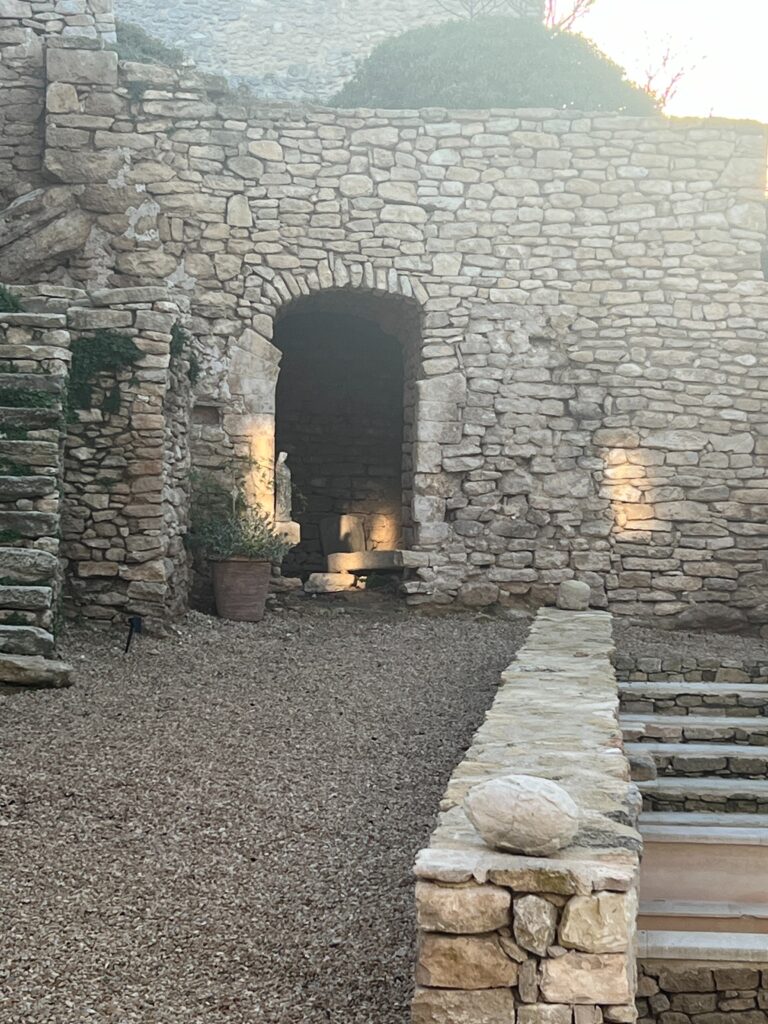
Right at that very moment, deep in thought, I noticed a beautiful ray of golden light slowly cast itself around her figure. This cannot be happening, I thought. I must be losing my mind. I scrambled across the room to get my phone to take a picture. My husband John, not yet knowing the fullness of the story, stopped what he was doing to witness this amazing light as well.
It has taken me over a year to finally follow through on my commitment to write about Little Things. The experience felt so monumental that I needed time to make sense of it. Who could have imagined all that would unfold after Adrienne’s comment and my desire to better understand the importance—the power—that resides in the space of small things.
It was as if sacred messages were being woven through this beautiful series of events—through roses, gestures of care, and the presence of people, both here and gone.
It certainly made me wonder how we might see our own life experiences in a different light if we stopped to observe what is happening just beyond the obvious, where the more invisible, yet precious energies are playing a hand in “one little thing leading to another.” If we could see and touch this more readily, we might begin to honor the sacred geometry in life, the inexplicable interconnection going on that paints a rather stunning tableau, should we stop to take it in.
Either way, it felt like a clear directive—a confirmation, a reaffirmation, a whisper in my ear—to never doubt the power and significance of little things. A flower, a thought, an act of kindness. Maybe these are the vessels that hold life’s beauty, where love is carried, uniting us all.
